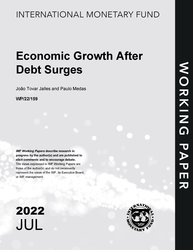
Economic Growth After Debt Surges
Economic Growth After Debt Surges
READ MORE...
Volume/Issue:
Volume 2022
Issue 159
Publication date: July 2022
ISBN: 9798400217227
$20.00
Add to Cart by clicking price of the language and format you'd like to purchase
Available Languages and Formats
| English |
Prices in red indicate formats that are not yet available but are forthcoming.
Topics covered in this book
This title contains information about the following subjects.
Click on a subject if you would like to see other titles with the same subjects.
Economics- Macroeconomics , Public Finance , Economics / General , Public debt , private debt , economic growth , potential GDP , investment , panel data , local projection , nonlinearities , debt surge , debt level , b Real GDP , changes in debt , robustness exercise , Output gap , Potential output , Public investment spending , Global , surge episode , a number of debt , debt surge episode , Private consumption
Also of interest
Summary
Debt levels, both private and public, were already at record highs before the Covid-19 pandemic, and surged further in 2020. The high indebteness raises concerns whether it will undermine future growth prospects. This paper contributes to the ongoing debate by examining what happens to economic growth after debt surges. We apply a local projection method to a new dataset of debt surges in 190 countries between 1970 and 2020. Our results show that the relationship between debt surges and economic growth are complex. Debt surges tend to be followed by weaker economic growth and persistently lower output. However, this negative relationship does not always hold. Surges in public debt tend to have the most negative impact on future growth prospects. This is particularly the case if the economy is already operating with a large positive output gap. Debt surges also tend to be followed by weaker economic growth if the initial debt levels are high, especially for private debt surges. Our results also show how debt surges impact future growth. Public debt surges are associated with especially weaker private and public investment, although both private and public consumption are also negatively affected. Surges in corporate debt are followed by lower private and public investment.
Copyright © 2010 - 2025
Powered by:
AIDC



